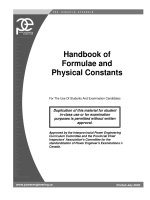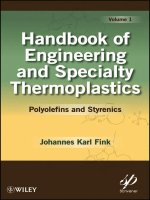Handbook of Engineering and Speciality Thermoplastics pdf
Bạn đang xem bản rút gọn của tài liệu. Xem và tải ngay bản đầy đủ của tài liệu tại đây (15.65 MB, 401 trang )
This Page Intentionally Left Blank
Handbook of Engineering
and Speciality Thermoplastics
Scrivener Publishing
3 Winter Street, Suite 3
Salem, MA 01970
Scrivener Publishing Collections Editors
James E. R. Couper
Rafiq Islam
Norman Lieberman
W. Kent Muhlbauer
S. A. Sherif
Richard Erdlac
Pradip Khaladkar
Peter Martin
Andrew
Y.
C. Nee
James G. Speight
Publishers at Scrivener
Martin Scrivener ()
Phillip Carmical ()
Handbook of
Engineering
and Speciality
Thermoplastics
Volume 1
Polyolefins and Styrenics
Johannes Karl Fink
Montanuniversität Leoben, Austria
Scrivener
)WILEY
Copyright © 2010 by Scrivener Publishing LLC. All rights reserved.
Co-published by John Wiley & Sons, Inc. Hoboken, New Jersey, and Scrivener Publishing
LLC,
Salem, Massachusetts.
Published simultaneously in Canada
No part of this publication may be reproduced, stored in a retrieval system, or transmit-
ted in any form or by any means, electronic, mechanical, photocopying, recording, scan-
ning, or otherwise, except as permitted under Section 107 or 108 of the 1976 United States
Copyright Act, without either the prior written permission of the Publisher, or authorization
through payment of the appropriate per-copy fee to the Copyright Clearance Center, Inc.,
222 Rosewood Drive, Danvers, MA 01923, (978) 750-8400, fax (978) 750-4470, or on the web
at www.copyright.com. Requests to the Publisher for permission should be addressed to the
Permissions Department, John Wiley & Sons, Inc., Ill River Street, Hoboken, NJ 07030, (201)
748-6011,
fax (201) 748-6008, or online at
Limit of Liability/Disclaimer of Warranty: While the publisher and author have used their
best efforts in preparing this book, they make no representations or warranties with respect
to the accuracy or completeness of the contents of this book and specifically disclaim any
implied warranties of merchantability or fitness for a particular purpose. No warranty may
be created or extended by sales representatives or written sales materials. The advice and
strategies contained herein may not be suitable for your situation. You should consult with a
professional where appropriate. Neither the publisher nor author shall be liable for any loss
of profit or any other commercial damages, including but not limited to special, incidental,
consequential, or other damages.
For general information on our other products and services or for technical support, please
contact our Customer Care Department within the United States at (800) 762-2974, outside the
United States at (317) 572-3993 or fax (317) 572-4002.
Wiley also publishes its books in a variety of electronic formats. Some content that appears in
print may not be available in electronic formats. For more information about Wiley products,
visit our web site at www.wiley.com.
For more information about Scrivener products please visit www.scrivenerpublishing.com.
Cover design by Russell Richardson.
Library of Congress Cataloging-in-Publication Data:
ISBN 978-0-470-62583-5
Printed in the United States of America
10 987654321
Preface
This volume on Polyolefins and Styrenics is the first part of a four-
part set on Handbook of Engineering and Specialty Thermoplastics. The
other three parts, to be published in late 2010 and
2011,
are on Poly-
ethers and Polyesters; Nylons; Water Soluble Polymers. The aim of
the Handbook is to keep the practitioner abreast of the recent devel-
opments in these subfields as well as to equip the advanced student
with up-to-date knowledge as he/she enters the industrial arena.
This volume focuses on common types of polymers belonging to
the class of polyolefins and styrenics. The text is arranged according
to the chemical constitution of polymers and reviews the develop-
ments that have taken place in the last decade. A brief introduction
to the polymer type is given and previous monographs and
reviews dealing with the topic are listed for quick reference. The
text continues with monomers, polymerization, fabrication techniques,
properties, application, as well as safety issues. Following this
information, suppliers and commercial grades are presented.
Even though materials are ordered according to chemical struc-
ture,
a great variety of individual materials belonging to the same
polymer type are discussed as well. In particular, the properties and
safety data given should be considered as indicative. The reader
who is actively engaged with the materials presented here should
consult the technical data sheets and the material safety data sheets
provided by the individual manufacturers.
How to Use this Book
Utmost care has been taken to present reliable data. Because of the
vast variety of material presented here, however, the text cannot
be complete in all relevant aspects, and it is recommended to the
reader to study the original literature for complete information. For
v
vi
this reason, the author cannot assume responsibility for the com-
pleteness and validity of, nor for the consequences of, the use of the
material presented here. Every attempt has been made to identify
trademarks; however, there were some that the author was unable
to locate, and I apologize for any inadvertent omission.
Index
There are four
indices:
an index of trademarks, an index of acronyms,
an index of chemicals, and a general index.
In the index of chemicals, compounds that occur extensively, e.g.,
"acetone", are not included at every occurrence, but rather when
they appear in an important context.
Acknowledgements
I am indebted to our university librarians, Dr. Christian Hasenhüttl,
Dr. Johann Delanoy, Dolores Knabl, Franz Jurek, Friedrich Scheer,
Christian Slamenik, and Renate Tschabuschnig for support in lit-
erature acquisition. I also want to express my gratitude to all the
scientists who have carefully published their results concerning the
topics dealt with here. This book could not have been otherwise
compiled.
Last, but not least, I want to thank the publisher, Martin Scrivener,
for his abiding interest and help in the preparation of the text and
Jane Higgins for careful proofreading.
Johannes Fink
19th February 2010
Contents
Preface v
1 Metathesis Polymers 1
1.1 Monomers 2
1.2 Polymerization and Fabrication 2
1.2.1 Metathesis Reaction 3
1.2.2 Catalysts 7
1.2.3 Rate Controlling 14
1.2.4 Molecular Weight Regulating Agents 17
1.2.5 Polymers 17
1.2.6 Copolymers 18
1.2.7 Thermosets 19
1.2.8 Reinforced Polymer Composites 21
1.2.9 Polymers with Functional Groups 23
1.2.10
Poly(acetylene)s 25
1.3 Properties 26
1.3.1 Mechanical Properties 26
1.3.2 Optical Properties 26
1.4 Fabrication Methods 27
1.5 Fluorinated Polymers 27
1.6 Special Additives 28
1.7 Applications 29
1.7.1 Packaging Films 29
1.7.2 Wire Coating Materials 29
1.7.3 Chromatographie Supports 30
1.8 Suppliers and Commercial Grades 32
1.9 Safety 35
References 35
vu
viii Engineering Thermoplastics: Polyolefins and Styrenics
2 Cyclic Olefin Copolymers 41
2.1 Monomers 41
2.2 Polymerization and Fabrication 43
2.2.1 Catalysts 45
2.2.2 Metallocene Catalyzed Polymerization 47
2.2.3 Addition Polymerization 48
2.2.4 Thermosetting Resins 50
2.2.5 Analysis 51
2.2.6 Solvent Bonding 51
2.3 Properties 52
2.3.1 Mechanical Properties 52
2.3.2 Thermal Properties 52
2.3.3 Optical Properties 52
2.3.4 Barrier Properties 52
2.3.5 Chemical Resistance 53
2.4 Applications 53
2.4.1 Films 53
2.4.2 Optical Applications 54
2.4.3 Medical Applications 58
2.4.4 Packaging Areas 59
2.4.5 Absorption of Organic Contaminants 62
2.4.6 Adhesives in Semiconductor Technology 63
2.5 Suppliers and Commercial Grades 65
2.6 Safety 65
2.7 Environmental Impact and Recycling 67
References 67
3 Ultra High Molecular Weight Poly(ethylene) 75
3.1 Monomers 75
3.2 Polymerization and Fabrication 76
3.2.1 Ziegler-Natta Catalysts 76
3.2.2 Mixed Catalysts 78
3.2.3 Single-Site Catalysts 79
3.2.4 Fractionation 80
3.2.5 Crosslinking 81
3.2.6 Fabrication 81
3.2.7 Porous Parts 82
3.3 Properties 82
Contents ix
3.3.1 Mechanical Properties 83
3.3.2 Electrical Properties 83
3.3.3 Optical Properties 83
3.3.4 Other Properties 83
3.4 Special Additives 83
3.5 Applications 84
3.5.1 Prosthetic Joints 84
3.5.2 Microporous Membranes 96
3.5.3 Binders for Filter Materials 99
3.5.4 Fibers 99
3.6 Suppliers and Commercial Grades 100
3.7 Safety 100
References 104
4 Poly(methyl)pentene 109
4.1 Monomers 109
4.2 Polymerization and Fabrication Ill
4.2.1 Ziegler-Natta Polymerization Ill
4.2.2 Metallocene Catalyzed Polymerization 112
4.2.3 Living Polymerization 114
4.2.4 Modification 114
4.2.5 Flash Spinning 116
4.3 Properties 118
4.3.1 Mechanical Properties 118
4.3.2 Thermal Properties 118
4.3.3 Electrical Properties 119
4.3.4 Optical Properties 119
4.3.5 Other Properties 119
4.4 Applications 120
4.4.1 Membranes 120
4.4.2 Heat Sealable Compositions 123
4.4.3 Laminates for Packaging Films 124
4.4.4 Overwrap Films 125
4.4.5 Image Forming Solution 126
4.4.6 Xerographic Devices 127
4.4.7 Acoustic Devices 128
4.4.8 Miscellaneous 129
4.5 Suppliers and Commercial Grades 132
x Engineering Thermoplastics: Polyolefins and Styrenics
References 133
5 Ionomers 137
5.1 Monomers 137
5.2 Polymerization and Fabrication 138
5.2.1 Processing 139
5.2.2 High Acid Types 139
5.2.3 Mechanisms of Crosslinking 140
5.3 Properties 143
5.3.1 Mechanical Properties 143
5.3.2 Thermal Properties 144
5.3.3 Electrical Properties 144
5.4 Special Additives 144
5.4.1 Antistatic Agents 144
5.5 Applications 145
5.5.1 Fuel Cell Anodes 145
5.5.2 Solar Control Laminates 145
5.5.3 Heat Seal Modifiers 146
5.6 Suppliers and Commercial Grades 146
References 148
6 Poly(isobutylene) 151
6.1 Monomers 151
6.2 Polymerization and Fabrication 152
6.2.1 Catalyst Systems 154
6.2.2 Polymerization Techniques 154
6.2.3 Poly(isobutylene) Grades 154
6.2.4 Star Shaped Polymers 155
6.2.5 Grignard Synthesis 156
6.2.6 End Group Functionalization 157
6.2.7 Blends and Composites 158
6.2.8 Halogenation Processes 161
6.3 Properties 161
6.3.1 Mechanical Properties 162
6.3.2 Thermal Properties 163
6.3.3 Electrical Properties 164
6.3.4 Optical Properties 165
6.3.5 Gas Permeation 165
6.3.6 Chemical and Physical Resistance 166
Contents
χι
6.4 Special Additives 166
6.5 Applications 166
6.5.1 Drag Reduction Additives 167
6.5.2 Oil and Fuel Additives 167
6.5.3 Polymeric Antioxidants 170
6.5.4 Emulsifiers 173
6.5.5 Chewing Gums 174
6.5.6 Medical Applications 175
6.5.7 Pressure Sensitive Adhesives 176
6.6 Suppliers and Commercial Grades 177
6.7 Environmental Impact and Recycling 179
References 179
7 Ethylene Vinyl Acetate Copolymers 187
7.1 Monomers 187
7.1.1 Vinyl Acetate 189
7.2 Polymerization and Fabrication 190
7.2.1 Radical Solution Polymerization 190
7.2.2 Aqueous Emulsions 192
7.2.3 Saponification 195
7.2.4 Foaming 196
7.3 Properties 197
7.3.1 Mechanical Properties 197
7.3.2 Optical Properties 197
7.4 Applications 197
7.4.1 Blends 197
7.4.2 Heat Seal Applications 198
7.4.3 Sealing 199
7.4.4 Waxes 201
7.4.5 Hot Melt Adhesives 202
7.4.6 Cold Flow Improvers 202
7.4.7 Drug Delivery 204
7.5 Suppliers and Commercial Grades 204
References 206
8 Acrylonitrile-Butadiene-Styrene Polymers 211
8.1 Monomers 211
8.1.1 Rubbers 213
8.2 Polymerization and Fabrication 215
xii
Engineering Thermoplastics: Polyolefins and Styrenics
8.2.1 Mass Polymerization 215
8.2.2 Emulsion Polymerization 218
8.2.3 Low Gloss Types 221
8.2.4 Blends 221
8.3 Properties 227
8.3.1 Mechanical Properties 227
8.3.2 Thermal Properties 228
8.3.3 Electrical Properties 229
8.3.4 Optical Properties 230
8.3.5 Surface Properties 231
8.4 Special Additives 231
8.4.1 Heat Stabilizers 232
8.4.2 Flame Retardants 232
8.4.3 Combined UV Stabilizer and Flame Retardant 234
8.4.4 Fillers 235
8.5 Applications 236
8.5.1 Foam Stops 236
8.5.2 Electroconductive Resins 236
8.5.3 Tunable Magneto Rheological Compositions . 237
8.5.4 Cement Additive 237
8.5.5 Membrane Materials 238
8.5.6 Electroless Plating 240
8.5.7 Encapsulation Shells for Phase Change Materials241
8.5.8 Hydrogen Storage 242
8.5.9 Carbon Materials 243
8.6 Suppliers and Commercial Grades 244
8.7 Safety 244
8.8 Environmental Impact and Recycling 247
8.8.1 Material Recycling 247
8.8.2 Pyrolysis 252
References 256
9 High Impact Poly(styrene) 269
9.1 Monomers 269
9.1.1 Impact Modifiers 269
9.2 Polymerization and Fabrication 270
9.2.1 Continuous Radical Polymerization 271
9.2.2 Rubbers 272
Contents xiii
9.2.3 Nanocomposites 274
9.3 Properties 275
9.3.1 Mechanical Properties 276
9.3.2 Thermal Properties 276
9.3.3 Particle Size 276
9.4 Special Additives 278
9.4.1 Flame Retardants 278
9.5 Applications 279
9.5.1 Foodservice Applications 279
9.5.2 Refrigerator Cabinets 281
9.5.3 Antistatic Compositions 282
9.6 Suppliers and Commercial Grades 283
9.7 Safety 283
9.7.1 Emissions from Processing 283
9.7.2 Emissions from Recycled Products 286
9.7.3 Accumulation in Food from Packaging 287
9.8 Environmental Impact and Recycling 288
9.8.1 Material Recycling 288
9.8.2 Feedstock Recycling 291
References 292
10 Styrene/Acrylonitrile Polymers 297
10.1 Monomers 297
10.2 Polymerization and Fabrication 297
10.2.1 Emulsion Polymerization 298
10.2.2 Intermediate Polymerization 298
10.2.3 Solution and Bulk Polymerization 298
10.2.4 Expandable Microspheres 300
10.2.5 Modification 300
10.2.6 Interfering Reactions 302
10.3 Properties 302
10.3.1 Mechanical Properties 303
10.3.2 Thermal Properties 303
10.3.3 Electrical Properties 304
10.3.4 Optical Properties 304
10.3.5 Chemical Resistance 305
10.4 Special Additives 306
10.5 Applications 306
xiv Engineering Thermoplastics: Polyolefins and Styrenics
10.5.1 Blends 306
10.5.2 Expandable Resins 308
10.5.3 Low Gloss Additives 308
10.5.4 Laser-inscribed Moldings 309
10.6 Suppliers and Commercial Grades 310
10.7 Environmental Impact and Recycling 310
References 312
11 Methyl methacrylate/Butadiene/Styrene Polymers 315
11.1 Monomers 315
11.2 Polymerization and Fabrication 316
11.2.1 Basic Method for Preparation 316
11.2.2 Varied Methods 318
11.3 Properties 318
11.3.1 Thermal Properties 319
11.3.2 Optical Properties 319
11.4 Special Additives 319
11.5 Applications 320
11.5.1 Medical Applications 320
11.5.2 Impact Modifiers 320
11.5.3 Thermoforming Applications 321
11.5.4 Aqueous Additive Systems 321
11.5.5 Prepregs 322
11.5.6 Powder Coatings 324
11.6 Suppliers and Commercial Grades 324
References 328
12 Acrylonitrile/Styrene/Acrylate Polymers 331
12.1 Monomers 331
12.2 Polymerization and Fabrication 332
12.2.1 Two Stage Preparation for Structured Latexes 333
12.2.2 Three Stage Preparation 334
12.2.3 Blends 335
12.3 Properties 336
12.3.1 Mechanical Properties 337
12.3.2 Optical Properties 338
12.3.3 Chemical Properties 338
12.4 Special Additives 338
12.4.1 Weatherability Improvers 339
Contents xv
12.4.2 Gloss Reducers 339
12.4.3 Heat Distortion Improving Agents 340
12.5 Applications 341
12.5.1 Multilayer Laminates 342
12.5.2 Roofing Material 342
12.5.3 Antimicrobial Acrylonitrile-styrene-acrylate . 343
12.6 Suppliers and Commercial Grades 343
References 345
Index 349
Tradenames 349
Acronyms 361
Chemicals 364
General Index 375
This Page Intentionally Left Blank
1
Metathesis Polymers
Polymers using the ring opening metathesis polymerization (ROMP)
technique were first obtained at 1960 by Eleuterio (1,2). The patents
deal with the polymerization of bicyclo[2.2.1]heptene-2, i.e., nor-
bornene using a molybdenum catalyst dispersed on alumina.
The polymer was found to contain double bonds in trans and cis-
configuration in considerable amounts. The mechanism of polymer-
ization has been described as shown in Figure 1.1.
Metal-catalyzed olefin metathesis had an enormous impact on
organic synthesis in general. Extensive research on mechanistic
aspects (3,4) and the development of catalysts has been performed,
which culminated in the award of the Nobel Prize for Chemistry in
2005 to Chauvin, Grubbs and Schrock.
G -
Figure 1.1: Metathesis Polymerization of Norbornene and Cyclopentene
1
2 Engineering Thermoplastics: Polyolefins and Styrenics
Table 1.1: Monomers for Metathesis Polymerization
Monomers References
Cyclopentene
1,5-Cyclooctadiene
Norbornene (1/2)
l,4-Dihydro-l,4-methanonaphthalene
Norbornene 2-ethylhexyl carboxylate (5)
Norbornene isobornyl carboxylate (5)
Norbornene phenoxyethyl carboxylate (5)
Dodecylenedinorbornene dicarboxyimide (5)
exo,e;ro-N,N'-Propylene-di-(norbomene-5,6-dicarboxyimide (5)
8-Methyltetracyclo[4.4.0.12.8.17.10]dodeca-3-ene (6)
Dicyclopentadiene (6)
1.1 Monomers
Cyclopentene is readily available as a byproduct in the ethylene
production. Norbornene 2-ethylhexyl carboxylate is obtained by
the Diels-Alder reaction of 2-ethylhexyl acrylate with cyclopenta-
diene (5). Norbornene isobornyl carboxylate, norbornene phen-
oxyethyl carboxylate, and other related monomers are synthesized
according to the same route. Polymers obtained from these esters
exhibit excellent properties in terms of controlling the crosslink-
ing density, the associated product modulus, and the glass tran-
sition temperature (T
g
), thus allowing tailoring the properties of
elastomers, plastics and composites. Other suitable monomers are
summarized in Table 1.1 and sketched in Figure 1.2.
1.2 Polymerization and Fabrication
The monomers dealt with can be polymerized by various mecha-
nisms, not only by ROMP. For example, a rapid polymerization
of norbornadiene occurs using a homogeneous catalytic system
consisting of nickel acetylacetonate or a nickel-phosphine complex,
such as nickel bis-(tri-n-butylphosphine) dichloride (NiCl2(TBP)2)
or nickel bis-(tricyclohexylphosphine) dichloride (NiCl2(TBP)2).
Nickel acetylacetonate as catalyst is known to initiate rather a clas-
sical vinyl polymerization (7). The classical vinyl polymerization
Metathesis Polymers 3
O ch
Cyclopentene Norbornene Dicyclopentadiene
*^® O
1,4-Dihydro-1,4-melhanonaphthalene 1,5-Cyclooctadiene
Figure 1.2: Monomers used for Metathesis Polymers
Figure 1.3: Difference Between Vinyl Polymerization and Ring Opening
Metathesis Polymerization (7)
of cyclic monomer deserves much less attention in the literature,
nevertheless there is a big variety of catalysts described (7).
By the way, the intended use of this polymer is as a solid high en-
ergy fuel (8). The difference between ordinary vinyl polymerization
and ring opening metathesis polymerization is shown in Figure 1.3.
1.2.1 Metathesis Reaction
The metathesis reaction consists of a movement of double bonds
between different molecules, as shown in Figure 1.4. Thus, the
metathesis reaction can be addressed as a transalkylideneation re-
action. The cleavage of the carbon-carbon double bonds was es-
tablished using isotopic labelled compounds that were subjected to
ozonolysis after reaction (9).
Clearly, if the radicals R\ and
R4
are connected via a carbon chain,
a longer chain will be formed, resulting consecutively in the for-
4 Engineering Thermoplastics: Polyolefins and Styrenics
R
4\
ßl R4V ßl
C=C C C
R
3
R
2
R3 R2
Figure 1.4: Scheme of Metathesis Reaction
Table 1.2: Types of Metathesis Reactions (10)
Term Acronym
Ring opening metatheses polymerization ROMP
Living ring opening metatheses polymerization LROMP (11,12)
Ring closing metathesis RCM
Acyclic diene metathesis polymerization ADMET
Ring opening metathesis ROM
Cross-metathesis CM or XMET
mation of macromolecular structures. For this reason, this type
of polymerization is also called ring opening polymerization. The
polymeric structures contain double bonds in the main chain. This
allows classical vulcanization processes with sulphur. Since the
reaction is reversible, the metathesis process has been used to syn-
thesize degradable polymers with vinyl groups in the backbone. In
this way, the structure of crosslinked rubbers has been elucidated.
The mechanism of metathesis is used in several variants, either
to polymerize, degrade, etc. The various reaction types are sum-
marized in Table 1.2. The metathesis reaction is catalyzed by metal-
carbene complexes. The mechanism, exemplified with cyclopentene
is shown in Figure 1.5. In the first step, the complex reacts with a
monomer to regenerate the carbon metal double bond. This double
bond is able to react further with another monomer thus increasing
the size of the molecule.
If the metathesis polymerization is performed in solution, the
preferred solvents are méthylène chloride or chlorobenzene. Prefer-
ably, the solvent is aprotic in order to avoid ionic side reactions. The
molecular weight is controlled by the addition of an acyclic olefin,
such as
1-butene
(13).
The polymerization reaction can be quenched by the addition
of alcohols, amines or carboxylic acids, such as ethanol, ferf-butyl
Metathesis Polymers 5
OH3 H CHQ H
H
3
C-¿
¿ ^\ ^
H
3
C-¿
¿=^Λ
OC
I
v
CO ^V\f
CO OC'I
v
CO
CO
Figure 1.5: Initial Steps of the Metathesis Polymerization
phenol, diethylamine, acetic acid. The polymerization reaction is an
equilibrium reaction. The relevant equilibria are
1.
Monomer-polymer equilibrium, in more general sense,
2.
Equilibrium between polymers of different chain length,
3.
Ring-chain equilibrium, and
4.
C/s-frans-equilibrium.
The free enthalpy of polymerization (AGp) is sufficiently negative
for rings of a size of 3, 4, 8, and larger to have the equilibrium on
the side of the polymer. However, for rings of a size of 5, 6, and
7 - because of the low ring tension - the free enthalpy of polymer-
ization can be even positive. For example,
AGa,p
for the formation
of the c/s-polymer of cyclohexene, AGo,p = +6.2 kjmol"
1
and for
frans-polymer of cyclohexene, AGo,p = +7.3 kj mol"
1
(14). Howev-
er, at cryogenic temperatures, AGp decreases and oligomers can be
formed.
The polymer contains a fraction of high molecular linear chains
and a cyclic oligomeric fraction. If initially the monomer concentra-
tion is below the equilibrium value for a linear polymer, essentially
no polymer is formed, but only cyclic oligomers. At higher concen-
tration, both a linear polymer and a cyclic oligomer is formed.
The ratio of the amounts of c/s-linkages to irans-linkages depends
on the nature of the catalyst. A tungsten or molybdenum cata-
lyst, respectively, can be prepared by heating tungsten trioxide with
phosphorus pentachloride in o-dichlorobenzene up to 120°C under
vigorous stirring. The solution changes from colorless to deep red
and a considerable amount of precipitate is left behind at the bottom
of the reaction vessel. The soluble chloride is used for the further
steps.
6 Engineering Thermoplastics: Polyolefins
and
Styrenics
Table 1.3: Monomers
for
ROMP Polymerization
(15)
Monomer Rate
3
f]
b
Cyclopentene
c
Bicyclo[2.2.1]heptene-2
c
5-Cyano-5-methyl-bicyclo[2.2.1]heptene-2
3,6-Methylene-l,2,3,6-tetrahydro-ris-phthalic anhy-
dride
2,3-Diethoxycarbonyl-bicyclo[2.2.1]hepta-2,5-diene
1,5-Cyclooctadiene
c
N-Phenyl-3,6-methylene-l,2,3,6-tetrahy-
dro-ds-phthalimide
N-Butyl-3,6-methylene-l,2,3,6-tetrahydro-cz's-
phthalimide
5,6-Dimethoxycarbonyl-bicyclo[2.2.1]heptene-2
5-(4-Quinolyl)-bicyclo[2.2.1]heptene-2
5-Acetoxy-bicyclo[2.2.1
]heptene-2
5-Methoxymethylbicyclo[2.2.1]heptene-2
A/,N-Diethyl-bicyclo[2.2.1 ]heptene-2-carbonamide
l,4-Dihydro-l,4-methanonaphthalene
5-Chloromethyl-bicyclo[2.2.1 ]heptene-2
5-(2-Pyridyl)-bicyclo[2.2.1]heptene-2
5,5-Dichloro-bicyclo[2.2.1
]heptene-2
a
Rate
of
polymerization/
[g
g
_1
h
_1
]
at
70°C except
for
monomers
with superscript
c
b
Viscosity/ [dig
-1
]
c
Polymerized
at
30°C
d
Solvent:
1,2-dichloroethane
e
Solvent: N,JV-dimethylformamide
The actual polymerization takes place in an autoclave under inert
atmosphere, where the supernatant liquid of the foregoing step is
placed with the dried and rectified monomer and the second cata-
lyst compound, namely diethylaluminum chloride in 1,2-dichloro-
ethane solution (15). The polymerization is conducted at 70°C for
60 min while stirring well. According to this recipe, a series of cyclic
monomers can be polymerized. Examples are shown in Table 1.3.
Macromonomers provide an easy access to a large number of
functional copolymers and controlled topologies, such as comb-like,
star-like, bottle brush, and graft copolymers. These types exhibit
exceptional solution or solid state properties compared to their linear
homologues.
1,590
1,365
1,365
1,283
1,264
1,202
1,182
1,121
1,039
998
978
978
937
897
876
876
815
2.05
d
1.88
d
1.22
e
0.97
e
1.17
e
1.98
d
1.05
d
1.07
e
0.70
e
0.81
e
0.85
e
0.69
e
0.94
e
0.78
d
0.80
d
0.81
e
l.ll
d
Metathesis Polymers 7
Initially, the polymerization of macromonomers was achieved by
free radical polymerization reactions, which allowed only a limited
control of the final properties. With the advent of ROMP and new
free radical polymerization techniques, such as atom transfer radical
polymerization (ATRP) the control of final properties became more
facile (16). ATRP and ROMP techniques can be combined for the
synthesis of macroinitiators (17).
Macromonomers with norbornene end groups were synthesized
by living anionic polymerization. The norbornene groups were
polymerized by molybdenum catalysts. A series of other ω-nor-
bornenyl macromonomers were synthesized and polymerized by
metathesis polymerization.
1.2.1.1
Living Ring Opening Metathesis Polymerization
Living ring opening metathesis polymerization is a special kind of
ROMP. In order to approach the conditions of a living polymeriza-
tion reaction, the following requirements must be fulfilled (12):
1.
Fast and complete initiation,
2.
Linear relationship between the degree of polymerization
and conversion, and
3.
Polydispersity less than 1.5.
Thus,
the catalyst must have certain special properties, to be
regarded as a living ROMP catalyst.
1.2.2 Catalysts
Numerous catalyst systems have been developed. Most common
catalysts are based on tungsten of molybdenum. Transition metals
ranging from group IV to group VIII have been found to be suitable.
The catalysts are commonly classified as given in Table 1.4.
The half-life times of the polymerization reaction can be adjusted
from a few seconds to several days. Typical for such catalysts is
the metalcarbene bond, as shown in Figure 1.5. In varieties of the
catalytic principle of the metalcarbene bond, this bond is not initially
present, but may be formed by a co-catalyst or by some reactions
with the monomer
itself.









